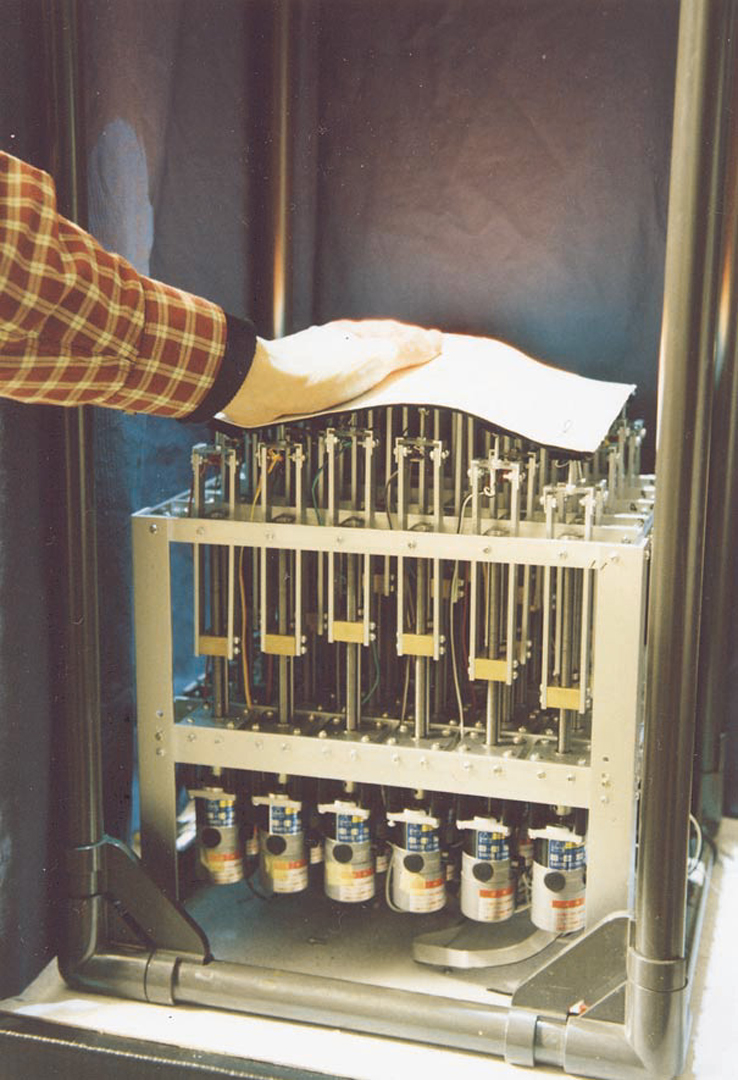“Project FEELEX: adding haptic surface to graphics” by Iwata, Yano, Nakaizumi and Kawamura
Conference:
Type(s):
Title:
- Project FEELEX: adding haptic surface to graphics
Presenter(s)/Author(s):
Abstract:
This paper presents work carried out for a project to develop a new interactive technique that combines haptic sensation with computer graphics. The project has two goals. The first is to provide users with a spatially continuous surface on which they can effectively touch an image using any part of their bare hand, including the palm. The second goal is to present visual and haptic sensation simultaneously by using a single device that doesn’t oblige the user to wear any extra equipment. In order to achieve these goals, we designed a new interface device comprising of a flexible screen, an actuator array and a projector. The actuator deforms the flexible screen onto which the image is projected. The user can then touch the image directly and feel its shape and rigidity. Initially we fabricated two prototypes, and their effectiveness is examined by studying the observations made by anonymous users and a performance evaluation test for spatial resolution.
References:
1. Brooks, F.P., et al. Project GROPE – Haptic Displays for Scientific Visualization. Computer Graphics, 24(4), 1990.
2. Burdea,G., Zhuang,J., Roskos,E.,Silver,D., and Langlana,L.,. A Portable Dextrous Master with Force Feedback. Presence, 1(1), 1992.
3. Burdea,G.C.,. Force and Touch Feedback for Virtual Reality. A Wiley-Interscience Publication, 1996.
4. G. Moy, C. Wagner, and R.S. Fearing. A Compliant Tactile Display for Teletaction. In IEEE Int. Conf. on Robotics and Automation, April 2000.
5. Hirota, K. and Hirose, M.,. Simulation and Presentation of Curved Surface in Virtual Reality Environment Through Surface Display. In Proc. of IEEE VRAIS’96, 1996.
6. Virtual Technologies Inc. http://www.virtex.com.
7. Iwata, H.,. Artificial Reality with Force-feedback: Development of Desktop Virtual Space with Compact Master Manipulator. ACM SIGGRAPH Computer Graphics, 24(4), 1990.
8. Iwata,H.,. Pen-based Haptic Virtual Environment. In Proc. of IEEE VRAIS’93, 1993.
9. Iwata,H.,. Desktop Force Display. In SIGGRAPH 94 Visual Proceedings, 1994.
10. Kawai,Y., and Tomita,F.,. A support system for the visually impaired to recognize three-dimensional objects. Technology and Disability, 12(1):13-20, 2000.
11. Kontarinis D.A., and Howe, R.D.,. Tactile Display of Vibratory Information in Teleoperation and Virtual Environment. Presence, 4(4):387-402, 1995.
12. Lederman, S.J. and Klatzky, R.L.,. Hand movements: A window into haptic object recognition. Cognitive Psychology, 19(3):342-368, 1987.
13. Lederman, S.J. and Klatzky, R.L.,. Sensing and displaying spatially distributed fingertip forces in haptic interfaces for teleoperators and virtual environment system. Cognitive Psychology, 8(1):86-103, 1999.
14. Massie,T., and Salisbury, K.,. The PHANToM Haptic Interface: A Device for Probing Virtual Objects. In ASME Winter Anual Meeting, DSC-Vol.55-1, 1994.
15. McNeely, W.,. Robotic Graphics:A New Approach to Force Feedback for Virtual Reality. In Proc. of IEEE VRAIS’93, 1993.
16. Minsky M, Lederman, SJ.,. Simulated Haptic Textures: Roughness. Symposium on Haptic Interfaces for Virtual Environment and Teleoperator Systems. In Proceedings of the ASME Dynamic Systems and Control Division,DSC-Vol. 58, 1996.
17. Murakami, T. and Nakajima, N.,. Direct and intuitive input device for 3D shape deformation. In ACM CHI 1994 Conference on Human Factors in Computing Systems, pages 465- 470, 1994.
18. Rabdolph, et al. Adding Force Feedback to Graphics System: Issues and Solutions. In Proceedings of SIGGRAPH 96, 1996.
19. Siio,I., . InfoBinder: A pointing Device for Virtual Desktop System. In Proceedings of HCI International ’95, 1995.
20. Sinclair, M.,. The Haptic Lens. In SIGGRAPH 97 Visual Proceedings, page 179, 1997.
21. Tachi,S.,and others. A Construction Method of Virtual Haptic Space. In Proc. of ICAT’94, 1994.
22. Underkoffler,J., Ullmer,B., and Ishii,H., . Emancipated Pixels: Real-World Graphics In The Luminous Room. In SIGGRAPH 99 Conference Proceedings, 1999.
23. Wellner, P.,. The DigitalDesk Caluculator: Tangible Manipulation on a Desk Top Display. In Proc. of ACM UIST’91, 1991.




